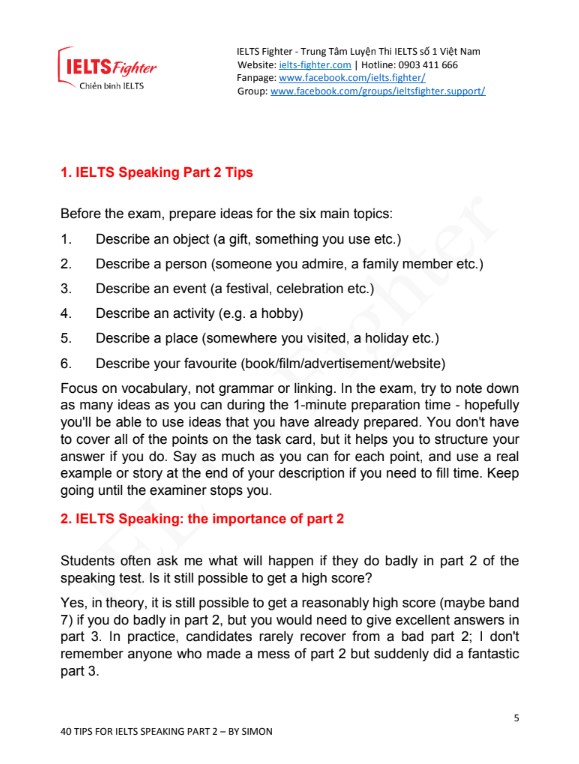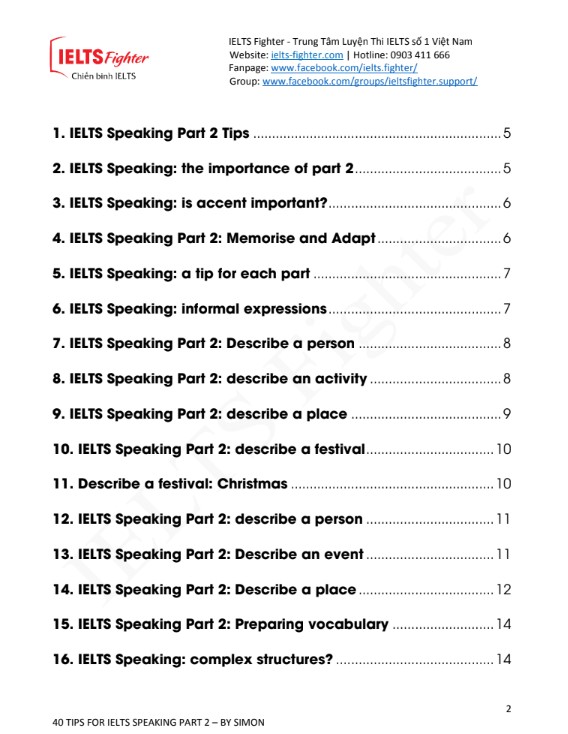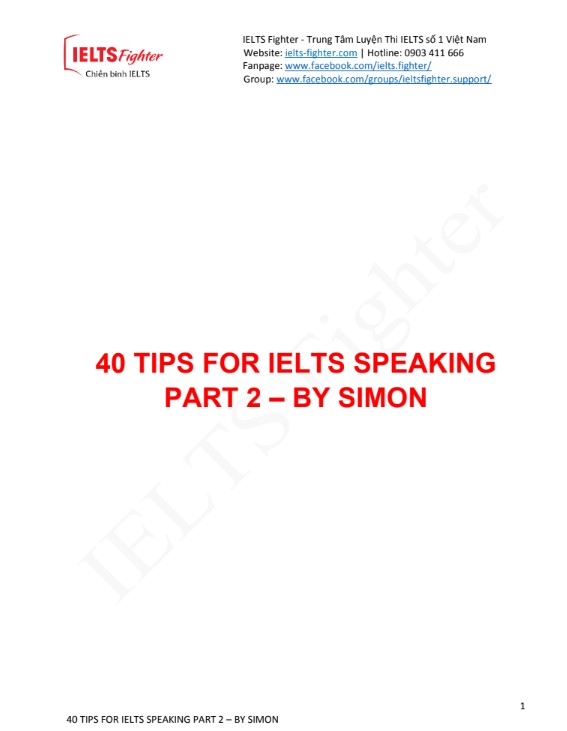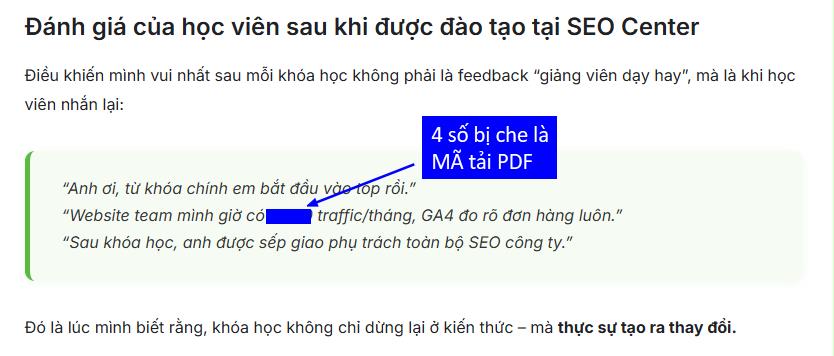


Dưới đây là nội dung được viết lại từ các hình ảnh bạn cung cấp (Mục lục và nội dung hướng dẫn IELTS Speaking):
MỤC LỤC (IELTS Speaking)
| Mục | Nội dung | Trang |
| 1. | IELTS Speaking Part 2 Tips | 5 |
| 2. | IELTS Speaking: the importance of part 2 | 5 |
| 3. | IELTS Speaking: is accent important? | 6 |
| 4. | IELTS Speaking Part 2: Memorise and Adapt | 6 |
| 5. | IELTS Speaking: a tip for each part | 7 |
| 6. | IELTS Speaking: informal expressions | 7 |
| 7. | IELTS Speaking Part 2: Describe a person | 8 |
| 8. | IELTS Speaking Part 2: describe an activity | 8 |
| 9. | IELTS Speaking Part 2: describe a place | 9 |
| 10. | IELTS Speaking Part 2: describe a festival | 10 |
| 11. | Describe a festival: Christmas | 10 |
| 12. | IELTS Speaking Part 2: describe a person | 11 |
| 13. | IELTS Speaking Part 2: Describe an event | 11 |
| 14. | IELTS Speaking Part 2: Describe a place | 12 |
| 15. | IELTS Speaking Part 2: Preparing vocabulary | 14 |
| 16. | IELTS Speaking: complex structures? | 14 |
| 17. | IELTS Speaking Part 2: Sample answer | 15 |
| 18. | IELTS Speaking Part 2: Describe a foreign person | 15 |
| 19. | IELTS Speaking Part 2: Describe a conversation | 16 |
| 20. | IELTS Speaking Part 2: Difficult questions | 17 |
| 21. | IELTS Speaking Part 2: Describe a skill | 18 |
| 22. | IELTS Speaking Part 2: Something naughty you did | 19 |
| 23. | Students’ Questions: Describe a newspaper | 19 |
| 24. | IELTS Speaking Part 2: Describe a building | 20 |
| 25. | IELTS Speaking Part 2: Describe a lesson | 21 |
| 26. | IELTS Speaking Part 2: Expanded answers | 22 |
| 27. | IELTS Speaking Part 2: Educational TV programme | 23 |
| 28. | IELTS Speaking Part 2: Describe a ‘success’ | 24 |
| 29. | IELTS Speaking Part 2: Describe a hobby | 25 |
| 30. | IELTS Speaking: A teacher’s questions | 26 |
| 31. | IELTS Speaking Part 2: ‘Local area’ answer | 27 |
| 32. | IELTS Speaking Part 2: ‘Prize’ answer | 28 |
| 33. | IELTS Speaking: ‘Future aim’ answer | 30 |
| 34. | IELTS Speaking Part 2: ‘Indoor game’ answer | 31 |
| 35. | IELTS Speaking Part 2: ‘School’ topic | 32 |
| 36. | IELTS Speaking Part 2: Family celebration | 33 |
| 37. | IELTS Speaking Part 2: Describe a market | 35 |
| 38. | IELTS Speaking Part 2: ‘Positive experience’ answer | 36 |
| 39. | IELTS Speaking Part 2: ‘Future plans’ answer | 37 |
| 40. | IELTS Speaking: Film Answer, verb tenses and vocabulary | 39 |
1. IELTS Speaking Part 2 Tips
Before the exam, prepare ideas for the six main topics:
- Describe an object (a gift, something you use etc.)
- Describe a person (someone you admire, a family member etc.)
- Describe an event (a festival, celebration etc.)
- Describe an activity (e.g. a hobby)
- Describe a place (somewhere you visited, a holiday etc.)
- Describe your favourite (book/film/advertisement/website)
Focus on vocabulary, not grammar or linking. In the exam, try to note down as many ideas as you can during the 1-minute preparation time – hopefully you’ll be able to use ideas that you have already prepared. You don’t have to cover all of the points on the task card, but it helps you to structure your answer if you do. Say as much as you can for each point, and use a real example or story at the end of your description if you need to fill time. Keep going until the examiner stops you.
2. IELTS Speaking: the importance of part 2
Students often ask me what will happen if they do badly in part 2 of the speaking test. Is it still possible to get a high score?
Yes, in theory, it is still possible to get a reasonably high score (maybe band 7) if you do badly in part 2, but you would need to give excellent answers in part 3. In practice, candidates rarely recover from a bad part 2; I don’t remember anyone who made a mess of part 2 but suddenly did a fantastic part 3.
My advice: You should consider part 2 as the core of your speaking test. It’s your best chance to show how good your English is, and it’s the examiner’s best chance to listen carefully to your use of language. In fact, it’s probably the point at which most examiners get a clear idea of what score to give you.
3. IELTS Speaking: is accent important?
People often ask whether their accent will affect their IELTS score. The simple answer is no. Your score for pronunciation depends on how clearly you speak and how intelligible (easy to understand) you are.
So if accent is not important, what are the factors that affect pronunciation? I really like the explanation on this page from the Warwick University website. They look at 5 key elements of pronunciation:
There are some great tips about improving your pronunciation near the bottom of the page, but my favourites are: work on your mistakes, copy good models of speech, record yourself, slow down, and try to sound interesting / interested!
4. IELTS Speaking Part 2: Memorise and Adapt
Memorising can be a good strategy for speaking part 2 because the same topics are often repeated.
But memorising can be a risky strategy unless you are able to adapt your answers to the specific question. For example, if you prepared a description of a holiday, would you be able to adapt it for the question about a positive experience you had as a teenager?
The smart way to study for part 2 is to prepare a few key topics, then spend lots of time practising ways to adapt what you prepared to other questions.
5. IELTS Speaking: a tip for each part
Here are 3 techniques to help you give longer, more detailed answers:
- Keep asking yourself “why?”
- Explain the alternatives
- Give an example
Here are three tips, one for each part of the speaking test.
Part 1: stop and smile
For part 1 of the speaking test, you need to get used to giving short answers. Many students find it difficult to stop speaking, and the examiner is forced to interrupt. My tip is to give your answer then stop and smile, showing the examiner that you are ready for the next question.
Part 2: tell a story
In the context of speaking part 2, a story is simply a long example to illustrate a point that you have made. If you’re describing a person, for example, you could tell a story to illustrate why you like him/her. People find it easy to keep speaking for longer when they have a story to tell.
Part 3: include an ‘if…’ sentence
Look at technique number 2 (Explain the alternatives). The ‘alternatives’ technique helps you to say more, and it also encourages you to add a conditional ‘if…’ sentence, which might help your grammar score.
6. IELTS Speaking: informal expressions
Yesterday I wrote about ‘an event’ for IELTS Speaking Part 2. Some of the expressions I used were informal:
- we chatted (talked)
- to get together with (meet)
- to catch up with (talk to someone you haven’t seen for a while)


